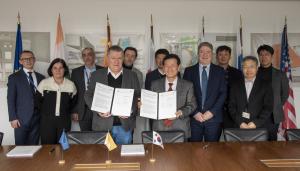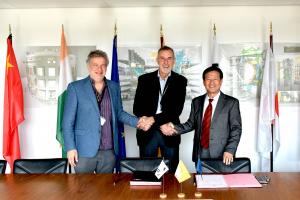Korea and Europe enter partnership
Test blanket modules are based on a simple physics principle: when a neutron impacts a lithium nucleus, the reaction produces one atom of tritium. An intense flux of neutrons will be generated once ITER enters full power operation and the Earth's crust contains abundant reserves of lithium. The challenge the ITER Test Blanket Module Program is facing is to turn a physics principle into an efficient tritium-producing and extraction system.
Test blanket modules are the breeding elements of the tritium breeding blanket systems that are being designed independently by China, Europe, and Japan. In addition, Korea and Europe are collaborating to develop a joint test blanket module concept¹. This collaboration was formalized by the signature of the Test Blanket Module Partnership Agreement between the two Members at ITER Headquarters on 1 March 2023. A second document called a Test Blanket Module Arrangement—involving the ITER Organization as nuclear operator—was signed one week later.
¹ Four different test blanket module concepts are being developed by the ITER Members and will be integrated into two equatorial ports for testing on ITER: water-cooled lithium-lead (Europe); water-cooled ceramics breeder (Japan); helium-cooled ceramics breeder (China); and helium-cooled ceramic pebbles (Europe/Korea). All ITER Domestic Agencies are carrying out R&D on different aspects of the test blanket systems (i.e., coolant, materials, tritium extraction...). Learn more about the ITER Test Blanket Module Program in this recent ITER Talk.



